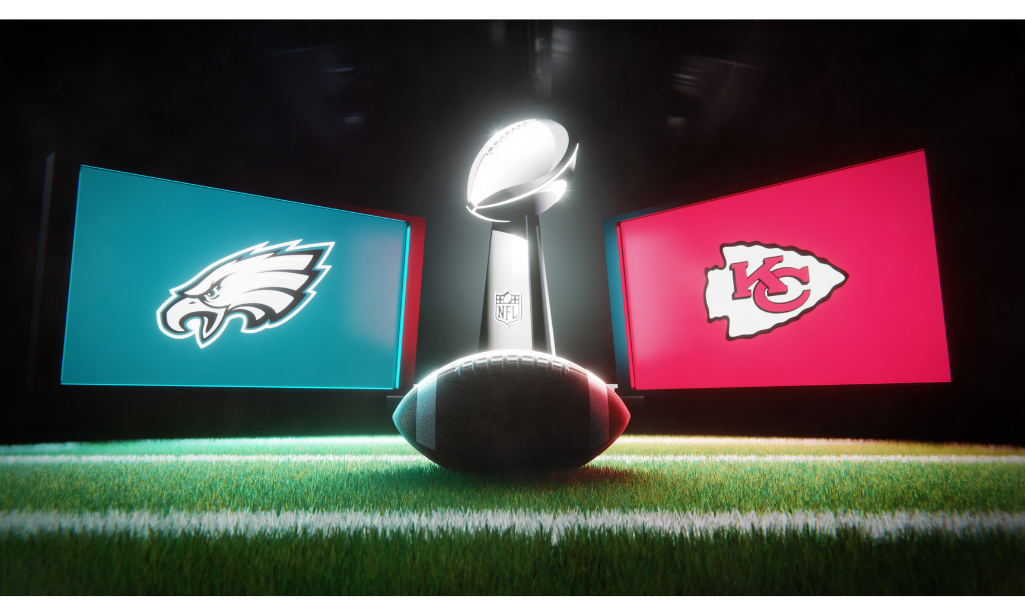It’s just about time for Super Bowl LVII! With excitement about football at a fever pitch, there’s no better time to work in some learning related to the science of the game. Though it may just appear to be a bunch of very large, strong, and fast men smashing into each other on a grass field, there’s actually quite a bit of science that goes into football. And that’s Today’s Lesson…the science behind football!
The Physics of Throwing a Football
Sticking with the Super Bowl LVII theme, this game will showcase the talents of two of the best quarterbacks in the NFL®. Jalen Hurts of the Philadelphia Eagles and Patrick Mahomes of the Kansas City Chiefs have made a name for themselves because of their overall athleticism. They both can run as well as they can throw…and can they ever throw! Whether it’s Mahomes finding future Hall of Fame tight end Travis Kelce on a precise slant route across the middle or Hurts heaving a 50-yard bomb downfield to his dynamic wide receiver duo of A.J. Brown and Devonta Smith, these quarterbacks have the arm strength and pinpoint accuracy to take apart just about any defense in the league.
So, how do they throw such perfect spirals to their receivers? There’s a lot of science that goes into it.
Distance
If you’ve watched a football game, you’ve likely noticed that deep passes are generally high, arcing throws. They almost resemble the shape of a rainbow if you were to draw the flight of the ball. Whereas short to intermediate throws are more often delivered on a straight line with higher velocity. The decision on how to throw the football depends on how much distance you want the throw to cover.
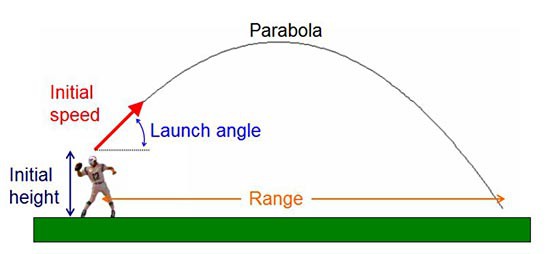
This is all explained by Newton’s law of gravity. For every action, there is an equal and opposite reaction. That’s why, on short throws, there’s very little arc or loft on the ball. For long passes, however, the quarterback is looking at the highest point on the arc on which he is throwing the ball. This is because he knows the ball must curve back down because of gravity and cover the distance at which he wants to throw.
But when throwing a football, the quarterback also must take launch angle into consideration. The launch angle is essentially the angle at which a quarterback lofts his throw. The higher the launch angle, the more height (but not necessarily distance) the ball will reach. For shorter passes, the ball will not reach a high launch angle. On deeper passes, the launch angle will generally be higher in order to reach the projected distance. (However, if the launch angle is very high, the ball will simply go straight up into the air. For deep passes, a 45-degree angle is ideal.)
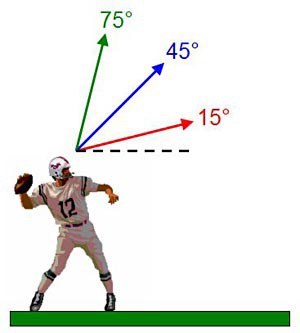
Football Aerodynamics
The shape of the football also plays a large role in how it is thrown. A football, obviously, is not a typical round ball. Its shape can be described as oblong or egg-shaped, with a point at each end and a thick middle. It’s important to account for the shape of the ball when throwing. If you’ve never seen a football thrown sideways, there’s a pretty sound reason for that–it won’t get far. Throwing the ball point first allows the ball to move through the air faster.
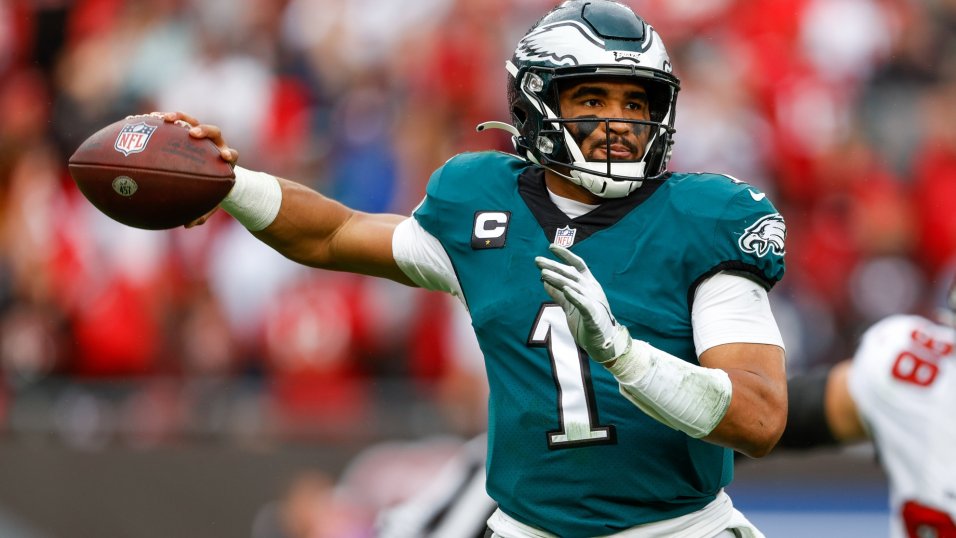
Mandatory Credit: Nathan Ray Seebeck-USA TODAY Sports
But there’s one more important factor when a quarterback wants to get distance on a pass–the spin. Why? Because the more a football spins, the more it penetrates the air and travels faster and further. And the key to creating a great spiral and a pass with distance is the grip on the ball. And the key to that is essentially two fingers. The idea is to place the middle finger and thumb in a straight line on the ball. The rest of the fingers wrap down and rest on the ball.
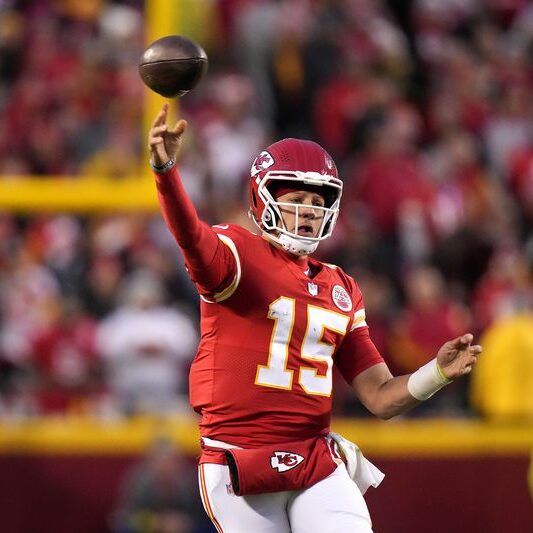
(AP Photo | Charlie Riedel) AP
Once the ball is ready to be thrown, the last thing a quarterback does is create spin on the ball. That is achieved when the index finger is the last finger touching the ball before it leaves the hand. The last flick of that index finger, finishing in a down motion, is what creates the spiral on a throw. On average, the spin rate of a good spiral is approximately 600 rotations per minute.
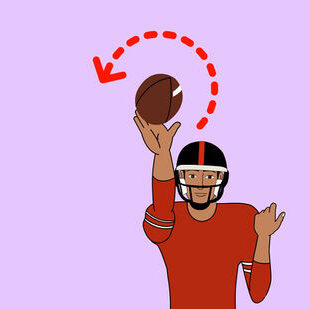
So, by creating as much spiral or spin on the ball as possible, the football will travel a little bit further than it would if the ball was thrown without a tight spiral. That’s because, when the ball is spinning rapidly and moving nose-first through the air, it encounters less air resistance…and that will help it travel farther. Velocity also plays a big part, because the more power you can apply to the throw and the spiral, the farther the pass will go.
The Science of Kicking a Football
Similar to the passing of a football, kicking a football relies on science–specifically physics. You may be watching your favorite team in the closing seconds, game on the line. Then the kicker comes in to attempt a game-winning field goal…and misses. Most people’s initial reaction is to scream at the kicker through the TV and incredulously ask how he missed! I’ve done it. But when you step back and look at all the elements involved in nailing the perfect kick (let alone the rest of the process, such as snapping the ball and holding it correctly), you realize just how difficult the job really is.
Field Goal Physics
Let’s look at a field goal attempt from a scientific perspective. Before the ball is struck by the kicker’s foot, its kinetic energy is zero. This would be when the holder has received the snap, placed the ball on the ground, and turned it to its proper position (laces out!). Then the kicker begins to run toward the ball in a straight motion, providing linear kinetic energy before contact. Once the foot strikes the ball, its path involves straight-line motion, meaning the ball’s kinetic energy is linear. According to Science Mill, the kinetic energy of the kicker’s leg is the most complicated form of kinetic energy. This is because it involves rotational kinetic energy of the kicker’s leg rotating about its hip joint, plus linear kinetic energy as the kicker’s leg travels with the kicker as he continues to run in straight-line motion after the collision.
Got all that? Once the ball is in the air, the science is very similar to a football pass–projectile motion. This demonstrates how forces such as gravity and air resistance affect the path of an object as it moves through the air…this is called trajectory. Like a pass needs to follow a certain trajectory through the air in order to land in the receiver’s hands, the football must follow a trajectory to make its way through the goalposts.
Launch Angles and Trajectories
Newton’s law of gravity comes into play when kicking field goals much as it does when throwing a pass. Just like a quarterback increases the launch angle to make a deeper throw, kickers often change their launch angles depending on the distance of a field goal. When kicking a short- to medium-range field goal (generally between 25 and 45 yards), the launch angle tends to be higher since the kick doesn’t need to travel a great distance. This allows the kicker to add height to the kick and reduce its chances of being blocked by the defense.
On longer kicks (anywhere from 46 to 65 yards), however, more velocity is required to reach the goalposts and forcefully make its way through the wind and air resistance. Therefore, kickers reduce the launch angle so the ball takes a less-arcing, straighter path and travels a greater distance. Of course, the downside to this approach is, the lower the kick, the greater chance there is for a defensive player to reach the ball and block it.
Notice how low the ball travels in this video, which shows Chiefs kicker Harrison Butker hitting a 70-yard field goal (!) in warmups before a game in Mexico City.
Conversely, note the angle of the Eagles’ Jake Elliott’s kick as he nails a 46-yard field goal in Super Bowl LII. While Butker’s kick, at its peak, barely reaches the halfway point of the goalposts height-wise, Elliott’s kick from a much shorter distance soars above the highest point of the goalposts while easily reaching its distance.
In general, most field goal kicks feature an average launch angle between 27 and 42 degrees.
The Kick Itself
There are many factors that go into a good kick.

- The hold: Most kickers prefer that the ball is held straight up and down rather than tilting. This allows the foot greater access to the ball’s “sweet spot.”
- The foot plant: For right-footed kickers, most place their left foot, heel first, next to the football…about 10 inches from the nose of the ball. Positioning himself this close and pointing his planted big toe directly at the goalpost, a kicker then opens his hips and draws power from the core torso muscles and legs.
- The…arm? Yes, the arm. By extending the left arm (for a righty kicker) straight out and keeping the body in balance while the hips and chest face the target, the kicker stays balanced, which can help accuracy.
- The contact: As the leg swings through, the top of the foot (by the tongue of your sneakers) strikes the ball’s sweet spot and powers through it. At this point, a kicker’s foot speed can reach up to 60 mph.
Take a look at Baltimore Ravens kicker Justin Tucker (one of the greatest, if not the greatest kicker in NFL history) as he progresses through a kick in slow motion. This one is also a 70-yard kick during practice.
Natural Factors
Temperature, wind, and air density also play major roles in games, especially from a kicking perspective. If wind is blowing in the direction of a kick, it will obviously give the football some extra velocity. If it’s blowing in the opposite direction, the kicker will need to apply much more force to his kick in order to break through the wind. When the wind is whipping from side to side (a kicker’s nightmare), he may have to overcompensate by kicking the ball further to the east or west so that the wind will push the ball back along a central path.
The temperature also plays a part. If you’re a baseball fan, you may have heard summer referred to as “hitting season”. That’s because, as the temperatures rise, the air becomes thinner, which allows baseballs to travel farther through the air. With football played in fall and winter, kickers often encounter frigid temperatures, which takes a bit of juice out of the football when kicked.
Additionally, geography has an impact on kicks as well. In the video clip above, Harrison Butker hit a 70-yard field goal during warmups in Mexico City…elevation 7,349 feet above sea level. The higher the elevation, the thinner the air. The thinner the air, the less air resistance there is on the ball. So, theoretically, field goals kicked in, say, Denver (a mile above sea level) should travel farther than kicks in New Orleans, which is 8 feet below sea level.
When you’re watching the Super Bowl–or any other football game–see if you can figure out how high or low a kicker might launch a field goal, depending on distance. And take note of the arc on a deep pass from the quarterback as opposed to a short pass. There’s a lot of science involved in these, and just about every other, aspects of a football game–and sports as a whole.
We hope you enjoyed Today’s Lesson! Subscribe to our blog for more fun lesson ideas and creative homeschooling tips and tricks!!






